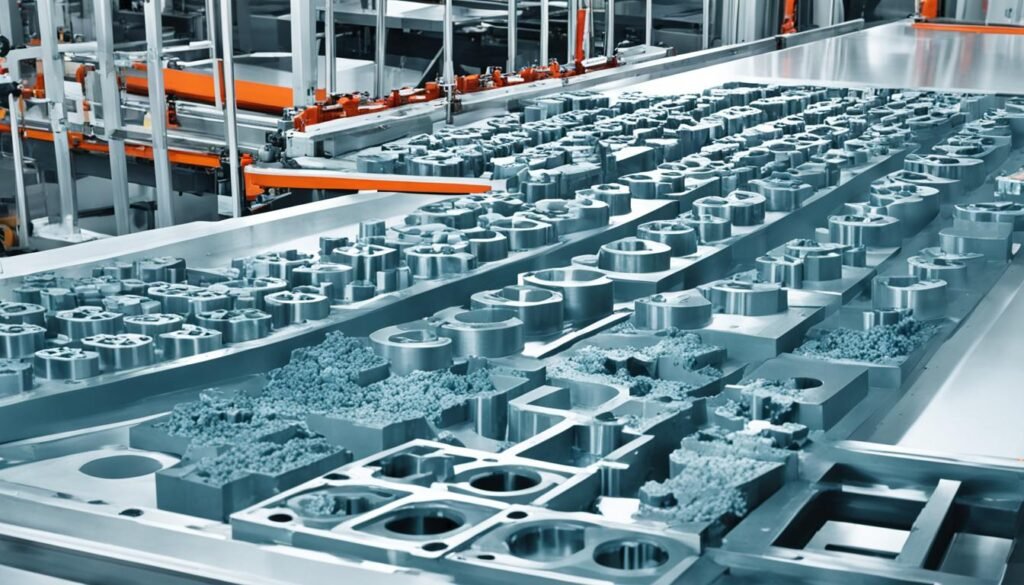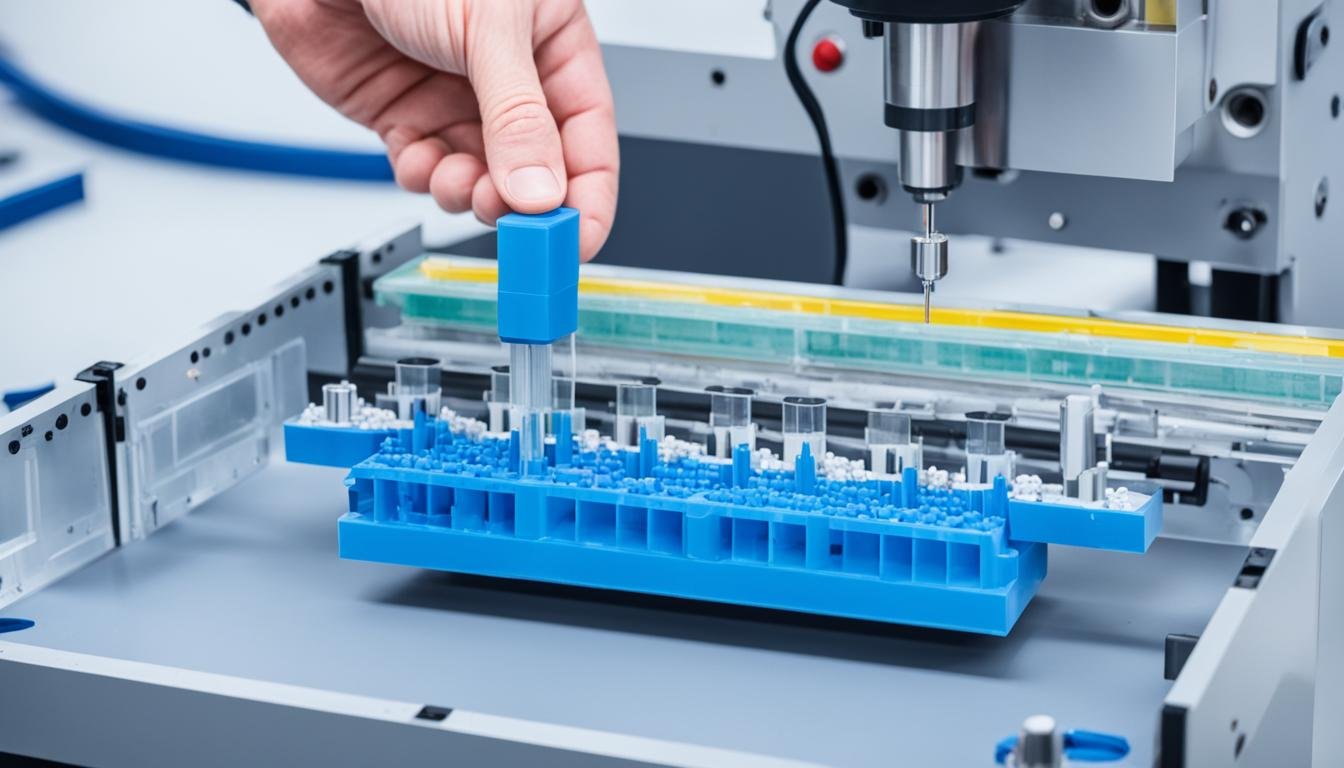The THY Precision injection moulding process step by step is a key way to make parts. It uses molten material that cools and takes the mold’s shape. Choosing the right material is key because it affects the final product’s quality.
Materials have different melting points and shrink rates. These can affect the success of the injection molding cyclemoulding process step by step>.
Choosing the right injection molding process step by step is vital. The melt delivery systemmoulding process step by step>, injection unitmoulding process step by step>, and clamping unitmoulding process step by step> are important. They affect the injection molding sequencemoulding process step by step> and mold fillingmoulding process step by step>.
Think about the material’s properties and how they work with the plastic injection moulding step by step machine. This helps make high-quality, consistent parts.
Key Takeaways
- The choice of material is critical in the injection moulding processmoulding process step by step> as it impacts the properties of the final product.
- Different materials have unique characteristics that can affect the success of the injection molding cyclemoulding process step by step>.
- Selecting the appropriate injection molding materialmoulding process step by step> is essential for the overall success of the injection molding stagesmoulding process step by step>.
- The melt delivery systemmoulding process step by step>, injection unitmoulding process step by step>, and clamping unitmoulding process step by step> all play a crucial role in the injection molding sequencemoulding process step by step> and mold fillingmoulding process step by step> process.
- Careful consideration of the material’s properties and how they interact with the various components of the plastic injection mouldingmoulding process step by step> machine is essential for producing high-quality, consistent parts.
Introduction to Injection Moulding Process Step by Step
At THY Precision, we know how key the injection moulding process step by step is for making top-quality, long-lasting items. This method has many steps, from getting the material ready to taking the part out of the mold. Each step is vital for the final product.
The injection molding cycle starts with getting the material ready. Our experts pick the right thermoplastic resin for the job, making sure it fits the product’s needs. Then, the material gets heated, melted, and mixed, ready to go into the mold.
Then, the mold filling stage happens. The melted material is pushed into the mold cavity. This step needs careful control of things like pressure, temperature, and flow rate. This makes sure the product fills evenly and turns out right.
Next, the mold cools, letting the part harden into its final shape. After it cools, the part comes out, ready for any final touches or putting together.
In this injection moulding process step by step, choosing the right material is crucial. Our team looks at the mechanical, thermal, and other properties of different thermoplastic resins. This helps us pick the best one for each project, making the manufacturing process a success.
“At THY Precision, we are committed to understanding the injection moulding process step by step and leveraging it to deliver exceptional products to our clients.”
Properties to Consider in Material Selection
Choosing the right material for injection moulding is key. It’s important to look at the material’s mechanical and thermal properties. These factors affect how well the final product will work.
Mechanical Properties
The strength and flexibility of a material are crucial. They help decide how long and well the product will last. The right material makes sure the product can handle what it’s meant to do.
Thermal Properties
Thermal properties are also vital. They include the melting point and how well the material conducts heat. The right thermal properties make the moulding process smooth and ensure the product works well in different temperatures.
| Property | Description | Importance in Injection Moulding Process Step by Step |
|---|---|---|
| Tensile Strength | The material’s ability to withstand pulling or stretching forces without breaking. | Ensures the final product can withstand the stresses and demands of its intended use. |
| Impact Resistance | The material’s ability to absorb and dissipate energy from sudden impacts or collisions. | Helps the final product maintain its integrity and functionality when subjected to unexpected impacts or shocks. |
| Flexibility | The material’s ability to bend or flex without breaking or cracking. | Allows the final product to adapt to various applications and environments without compromising its structure. |
| Melting Point | The temperature at which the material transitions from a solid to a liquid state. | Determines the optimal processing temperature range for the injection moulding process step by step, ensuring efficient and consistent part production. |
| Thermal Conductivity | The material’s ability to transfer heat from one area to another. | Affects the cooling and solidification of the molten material during the injection moulding process step by step, impacting the final product’s dimensional stability and performance in different temperature environments. |
By looking at the mechanical and thermal properties, THY Precision can pick the best material. This ensures the product meets its needs and the manufacturing process goes smoothly.

Amorphous vs. Semicrystalline Thermoplastics
Choosing the right thermoplastic material is key in the injection moulding process. There are two main types: amorphous and semicrystalline. Knowing their differences is vital for great results.
Amorphous thermoplastics, like acrylic and polycarbonate, are very flexible and can be shaped easily. They are great for many injection moulding uses. But, they don’t handle chemicals as well as semicrystalline ones.
Semicrystalline thermoplastics, such as polyethylene and polypropylene, have a clear melting point and resist chemicals well. They’re often chosen for things that need to last a long time and stay strong against chemicals. But, they can be harder to shape because of their sharp melting point.
| Property | Amorphous Thermoplastics | Semicrystalline Thermoplastics |
|---|---|---|
| Softening Temperature Range | Wide | Sharp |
| Formability | Excellent | More Challenging |
| Chemical Resistance | Poor | Superior |
It’s important to know the differences between amorphous and semicrystalline thermoplastics when choosing for injection moulding. Think about what your project needs to pick the best material. This way, you can make sure your final products work well and look good.
Common Injection Moulding Materials
Choosing the right materials for injection moulding is key. Polyethylene (PE) and polypropylene (PP) are top choices. They each have special features that affect the final product.
Polyethylene (PE)
Polyethylene is a light, versatile plastic used often in injection moulding. It stands out for its strong chemical resistance, low cost, and large production capacity. PE is great for packaging, containers, and home items because it’s tough and flexible.
Polypropylene (PP)
Polypropylene is known for its strength and stiffness. It’s a top pick for car parts, home items, and packaging because it resists chemicals well and can handle high temperatures. PP is also ideal for food packaging because it keeps heat out.
| Material | Key Properties | Common Applications |
|---|---|---|
| Polyethylene (PE) | – Lightweight – Excellent chemical resistance – Low cost – High-volume production | – Packaging – Containers – Household goods |
| Polypropylene (PP) | – Strong and stiff – Excellent chemical resistance – High-temperature tolerance – Suitable for food packaging | – Automotive parts – Household goods – Packaging |
Working with polyethylene or polypropylene requires knowing their unique traits. This knowledge is vital for a successful injection moulding process.
Material Selection Factors
Choosing the right material for your injection molding project is key. At THY Precision, we know how important this choice is. It affects the injection moulding process step by step, how well the product works, its cost, how efficiently it’s made, and its effect on the environment.
First, think about product performance. The material must match what your product needs, like strength, durability, flexibility, and looks. This makes sure your product does what it’s supposed to and looks good too.
Cost-effectiveness is also vital. You need to look at the total cost, including the price of raw materials, how it’s made, and waste. This way, you can keep your injection moulding process step by step affordable and profitable.
How easy the material is to process is another big factor. It should be easy to work with, create little waste, and have consistent quality. This makes your injection moulding process step by step smoother, cuts down on downtime, and boosts productivity.
Thinking about the environmental impact is also crucial. More and more, customers and rules want us to be more eco-friendly. The material you pick should be good for the planet, create little waste, and use less energy in the injection moulding process step by step.
Last, make sure the material you choose meets all the rules and standards. This means it has to be safe, quality, and perform well, and have any needed certifications or approvals for your market.
By thinking about these factors, you can make your injection moulding process step by step better. You’ll make products that customers love, keep costs down, work efficiently, and help the environment.
Impact of Material Selection on Manufacturing Process
Choosing the right material for THY Precision’s injection moulding is key. Things like strain rate and melt flow rate affect how the material works and how easy it is to process. Electrical properties and flammability also matter, depending on what the product will be used for.
It’s important to know how the material’s traits affect the manufacturing process. This ensures the final product is just right. By looking at these factors, THY Precision can make the best parts for their customers.
Strain Rate and Melt Flow Rate
The strain rate and melt flow rate of the material change how easy it is to make the product. Materials with a high strain rate need more energy to process. Those with a low melt flow rate are harder to fill into the mold. THY Precision must think about these things to make the process smooth and efficient.
Electrical Properties and Flammability
For certain uses, the material’s electrical properties and flammability are key. If a product needs to be electrically insulated or safe from heat and fire, THY Precision picks materials with the right traits. This ensures the product is safe and works as it should.
| Property | Impact on Manufacturing Process |
|---|---|
| Strain Rate | Affects energy input requirements and processing ease |
| Melt Flow Rate | Influences material’s ability to fill the mold |
| Electrical Properties | Crucial for products requiring electrical insulation or resistance |
| Flammability | Important for products that must meet fire safety standards |
By thinking about how the material affects the process, THY Precision can improve their work. They can make sure their products are top-notch and meet customer needs.

“Selecting the right material is crucial for the success of any injection molding project. It’s not just about the final product, but the entire manufacturing process.”
Case Studies and Real-World Examples
At THY Precision, we know how important choosing the right material is in the injection moulding process step by step. We’ve put together case studies and examples to show how picking the right material changes the game. These stories highlight how the right material can make a product strong, long-lasting, and affordable in many fields.
A leading car maker teamed up with THY Precision for a new dashboard part. They picked a special plastic that could handle impacts well and stay stable in heat. This choice made the dashboard safe, look good, and last a long time. It was a big win for the product.
| Industry | Material Selection Impact | Outcome |
|---|---|---|
| Automotive | Enhanced impact resistance and thermal stability for dashboard component | Durable, safe, and aesthetically pleasing final product |
| Consumer Electronics | Lightweight, high-strength material for smartphone casing | Reduced product weight, improved drop resistance, and enhanced user experience |
| Medical | Biocompatible, sterilizable material for surgical equipment | Increased patient safety and compliance with regulatory standards |
In the world of consumer electronics, THY Precision helped a smartphone maker with a new case design. They chose a material that was both light and strong. This made the phone lighter, more resistant to drops, and better for users.
For medical needs, THY Precision worked with healthcare providers on surgical tools. They picked materials that were safe for the body and could be cleaned well. This made sure the products were up to the law and kept patients safe during the injection moulding process step by step.
These stories show how big a deal material choice is for injection-molded products. By thinking about what each material can do, THY Precision has made products that are new, strong, and save money. They meet the changing needs of many industries.
Conclusion
Choosing the right material is key in the injection moulding process. It affects the product’s properties, performance, and cost. By knowing about mechanical and thermal properties, and the differences between plastics, manufacturers can make smart choices. This leads to making high-quality injection-molded parts.
The guide on selecting materials for injection moulding is very helpful. It ensures the product meets the needed standards, is made efficiently, and has a low environmental impact. THY Precision uses this guide to pick materials that are right for the job. This makes the manufacturing process better in quality and efficiency.
THY Precision focuses on choosing the right materials for injection moulding. This results in products that are strong, affordable, and good for the environment. The end result shows how important material selection is. It also shows THY Precision’s commitment to excellence in every step of the process.




